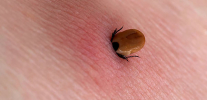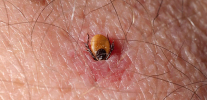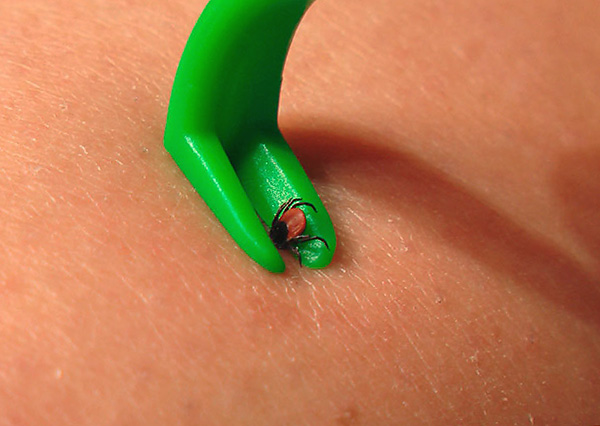
Safely unscrewing a sucked mite from the skin is a fairly simple procedure and does not require any special skills or dexterity. For a person who often happens in the wild in a region where there are many of these parasites, such removal generally turns into an ordinary routine: sometimes in one day spent on a hunt or in a hiking trip, you have to take several dozen ticks from your colleagues and yourself. With due experience, the process is brought to automatism - literally in half a minute, an experienced person can unscrew a tick with a well-developed movement, even in the absence of special devices (gables).
On a note
It is often possible to observe how experienced hunters, fishermen or tourists extract ticks at all in the way that doctors or entomologists recommend doing to unprepared people.From the side it may seem that a person simply tears the parasite from the skin, without even trying to twist it. And interestingly, everything happens quickly, painlessly and safely (the skin of the parasite does not remain in the skin).
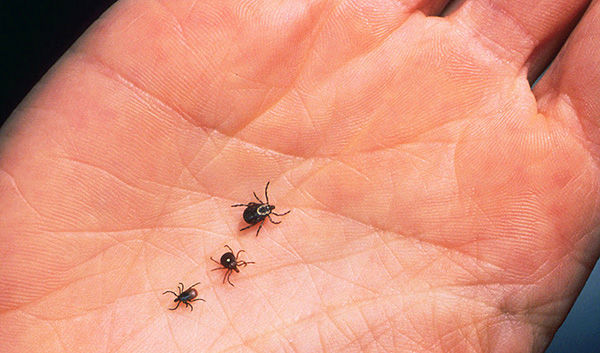
However, if there is not enough experience and developed skills, it is necessary to remove the sucked tick from the skin using a certain method, observing the precautions. Such an extraction ensures that the tick will not break and that no part of its body will remain in the skin.
Next, we will look at how to properly unscrew the tick and why the myth is widespread that it certainly needs to be rotated clockwise, and not against. In addition, let us consider with what devices it is possible to significantly facilitate the process of extracting the parasite (including from hard-to-reach places) and how to estimate the probability of infection with tick-borne encephalitis and borreliosis ...
The main rule of extraction of ticks: twist, but not pull
The specificity of the structure of the head and oral apparatus of the tick is such that when it is sucked it is most reliably protected from its separation from the body of the host. This is the biological meaning of the complex anatomy of the gnatosome (the head with the oral organs) - its structure is such that, having had time to suck, the parasite does not exactly fall from the owner's body, even with intentional shaking off. The more secure the tick is in the skin, the more chances it has to fully nourish and then give birth to offspring.
See also article about tick structure and how it works during a bite.

The parasite is less protected from twisting (few of its wild owners are able to capture the body of the tick and rotate it several turns around the axis). Therefore, protection mechanisms for twisting movement of ticks, in fact, not because of their uselessness.
But from a simple separation, they are protected well:
- The fingers of the chelicera on the hypostome (proboscis) after the eruption of the skin are set apart and bulged here, preventing the parasite from being extracted;
- Liquid salivary secretion enveloping the mite proboscis, hardens in the wound, forming a cemented case. This case is firmly fixed in the wound, because in its lower part it spreads in the dermal layer of the skin and also forms a solid construction here that has a greater width than the hole made in the skin. The outer walls of the case initially “spread out” in the intercellular space, and when cured, they are practically embedded in the skin;
- Additionally, by a hypostom, like a harpoon, it is firmly fixed due to the presence of a multitude of notches on its surface.
The image shows the layout of the oral apparatus of the tick in the skin while feeding:
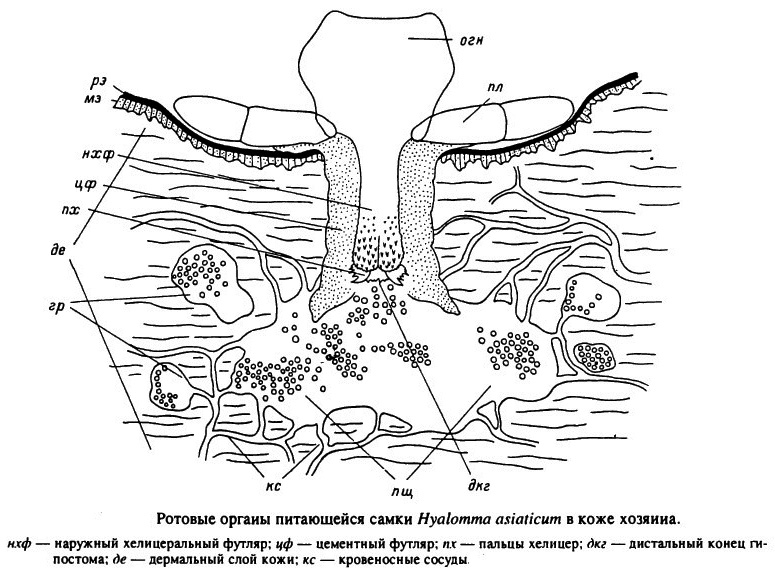
As a result, in order to pull the tick out of the skin, one must either destroy the joint between the notches on the hypostome and the case, or “break” the case itself.
In fact, the strength of the site of articulation of the mite head with the body is lower than the strength of adhesion of the hypostome with the cementing case and the strength of the case itself. This means that if such a case has been formed and has already cemented, then when trying to tear off a stuck parasite, its gnathosoma with a case will most likely come off the body and remain in the skin.
But if you start to unscrew the tick gently, the notches on the hypostome will simply scratch a part of the cement case, and after 2-3 turns the mouthpiece of the parasite will be quite easy to move in this case. Coupling with the case is broken, and the proboscis can be easily removed from the skin - it is on this principle that the parasite is twisted.
This is how a proboscis mite looks like under a microscope:
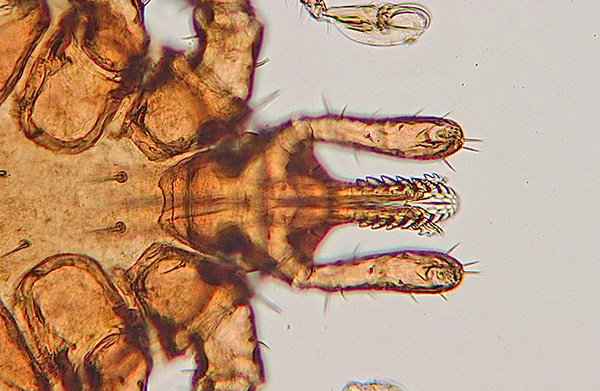
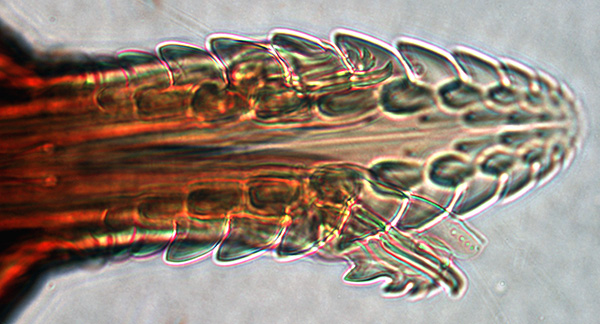
On a note
In this case, swinging the tick from side to side is ineffective. The fact is that the articulation of its head with the body is movable, and the swinging of the idiosome only leads to the movement of the body of the parasite in the place of this joint. At the same time, no significant displacement of the proboscis in the case or the case in the skin does not occur, and, therefore, the engagement of the parasite does not weaken, and pulling it out of the skin will be just as unsafe as without preliminary rocking.
There are several other nuances that it is useful to know for a better understanding of the method of unscrewing ticks, as well as explaining why, in some cases, it is quite safe to simply remove the parasites from the skin (without twisting).
First: when biting, not all ticks form a case of solidifying saliva, and of those with which it forms, it is not always reliable.
For example, the most common ticks in Russia (and the most dangerous carriers of tick-borne encephalitis are canine and taiga tick), as well as in the infamous Australian paralytic mite, females do not form such a case, but are kept in the cut wound only due to the skin tone, which is tightly compressed around the hypostome with teeth, as if capturing it. In this case it is easier to pull out the proboscis than from the hardened case.
The picture below shows the jaws of the female taiga tick during feeding (in this case there is no case between the skin and the hypostomy):
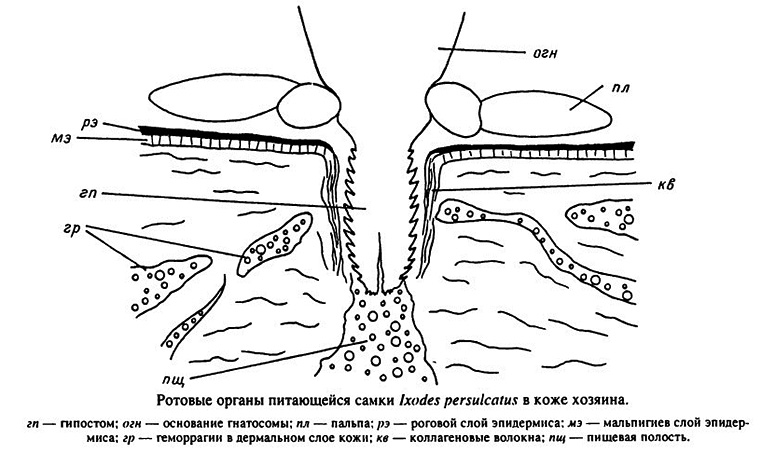
On a note
Representatives of some other types of ticks after probing holes in the skin remove the proboscis from it, and then suck blood and inflammatory infiltration, in parallel introducing anti-coagulant enzymes here and not allowing the wound to drag out. They have a case formed on the surface of the victim's skin, and although it allows you to hold the tick, it is very easy to tear the parasite with the case itself.
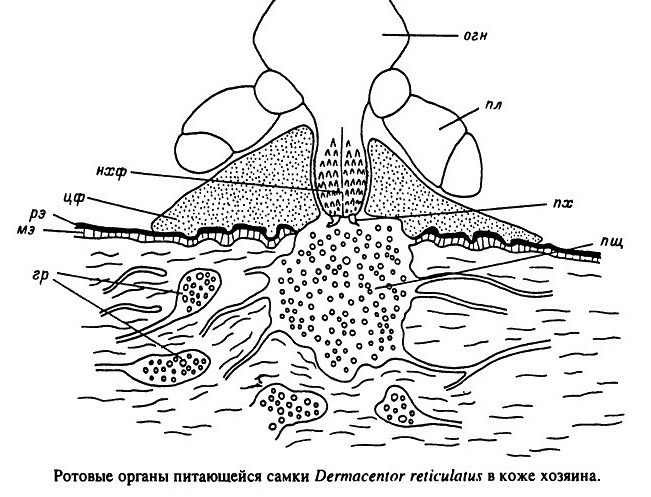
Second: the case around the parasite's proboscis is completely formed and solidifies approximately 30-50 minutes after ingestion into the skin. During this time, it is quite simple to pull out the tick, and the probability that it will not be completely removed (with a separation of the mouth organs) is small.
And finally, the third: in small mite nymphs, the case and the mouth organs themselves are relatively small, and their strength is lower than the strength of the articulation of the gnatosome with the idiosome (torso). Therefore, immature individuals are most often completely safely pulled out even without twisting.
On a note
In practice, it is usually not possible to say in advance exactly how firmly the tick is in the skin of a person, dog or cat, whether its case has formed and how deep it is in the skin.Neither a mite nor a non-expert can determine the stage of its development. Therefore, for maximum safety of the victim, any sucked tick is better to gently twist, and not tear.
How to twist the parasite
The main task in unscrewing a tick is to rotate precisely its oral apparatus in the skin or in a cement case. This is not the same as rotating the body of the parasite, which is easy to grasp even with your fingers - if you try to rotate the body, you can easily “unscrew” it from the head, which will remain in the wound.
To unscrew the oral apparatus of the tick, it is necessary to rotate its head. This is often difficult to do, because in a parasite that feeds on, the body is much larger than the head and prevents from grasping it, and in some species the head generally completely sinks into the skin during a bite.
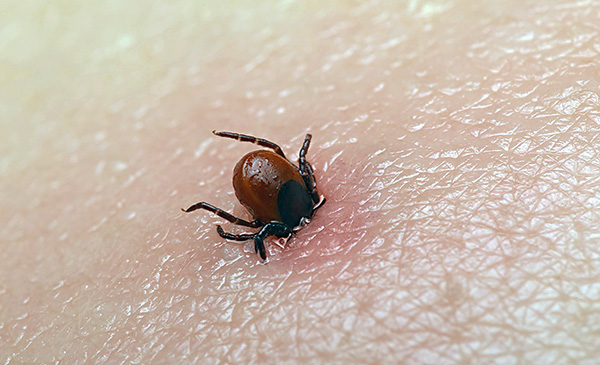
In addition, in small nymphs the head is so small that it is almost impossible to capture it without special devices. In such situations, special mite extractors (tick-borne catchers), which allow capturing the gnatosome, are very helpful in unscrewing the tick.
For details on such devices, see.in a separate article: Devices for removing ticks: choose an effective twisting tool.
The photo below shows the structure of the mite gnatosome - its head and mouth organs:
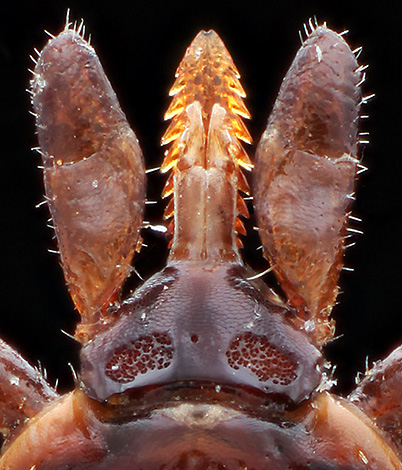
Practice shows that after capturing the tick head and turning it for several turns, the engagement of the jaws in the skin weakens to such an extent that the parasite drops out almost without pulling it up (this can be done either clockwise or counterclockwise).
Thus, the whole technology of twisting the mite is reduced to three simple points:
- Any device needs to capture the head of the parasite under the body, as close as possible to the skin;
- Rotate the parasite 2-3 full turns;
- Then it is very easy to pull up, check whether the proboscis is removed from the skin. If removed - remove, and if not removed - do another couple of turns.
On a note
In most cases, it is not even necessary to pull the tick after a few turns, since it falls out by itself. This is partly due to the fact that when turning the person unwittingly pulls the parasite up, which is enough to unfasten it. Also, due to the fact that some devices literally run into the tick from below (from the skin), they themselves push the tick as soon as its fixation in the skin weakens.
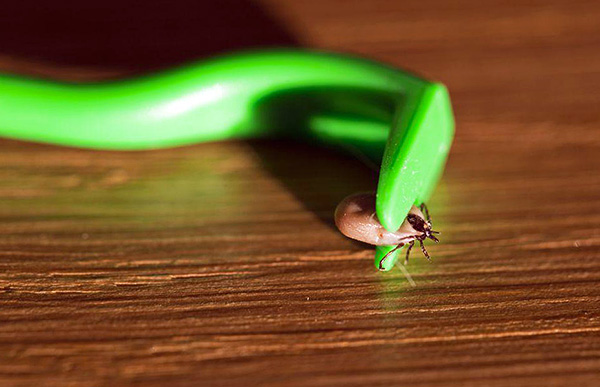
As already noted above, it makes absolutely no difference in which direction to unscrew the tick: there is no specific “thread” on its proboscis (it is symmetrical), it turns in both directions with the same effort and equally quickly falls wherever it is rotated.
However, in practice, in most cases, the tick is twisted clockwise. This is due to the fact that most people manipulate the tongder-head with their right hand, and it is more convenient to twist it from the thumb to the index finger - so the angle of rotation at a time is greater. Rotation in this case occurs in a clockwise direction.
It is not surprising that in almost all instructions and videos about unscrewing a tick, it spins exactly in a clockwise direction (as viewed from above, from the observer), and with his right hand. The spectators can unwittingly create the deceptive impression that it is only in this direction that the tick needs to be twisted. This is wrong: you can twist in any direction, the main thing is to rotate only in one direction.
Pincers for twisting
Pulling ticks is more convenient and quicker than all with special devices, the design of which is specially designed to solve this problem.
The most common version of such a product - hook hook. The photo below shows this classic tool:
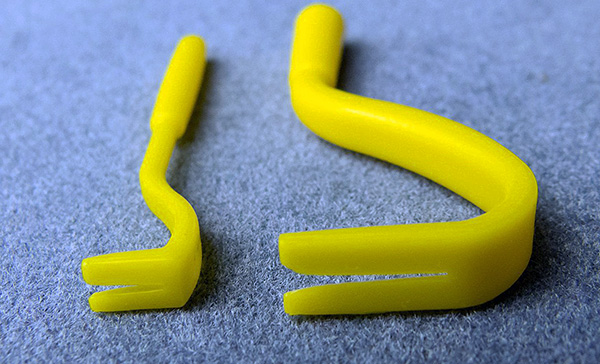
It is seen that the lower part of it is expanded and bifurcated. This part of the tick is picked up under the body, its head falls exactly into the slot and is fixed by it.
Due to the fixation of the head, the rotation of the hook leads to the rotation of the entire parasite, including its mouth apparatus in the wound. After 2–3 full revolutions, the mite falls out of the skin and remains in the mite holder.

These hooks are available under different brands and may vary slightly in shape. For example, Uniclean Tick Twister (France), Trixie Tick Remover (Germany), Rolf Club 3D (Russia), as well as unnamed products of Chinese origin are known.
All such devices have several common advantages:
- Due to the long handle, they allow the tick to be pulled out not only from the skin of a person, but also from the hair of a dog or cat, and it is rather long;
- Low price (on average, they cost about 150-200 rubles);
- Such devices are very durable and reliable - they have practically nothing to break.
In addition to hooks, there are other pliers on sale:
- Flat key extractors in which the mite is caught by a groove in the inner hole.Their advantage is that they have a flat shape and are conveniently worn in a wallet or keychain. However, due to the need to rotate the entire key around the axis, they do not allow removing ticks in narrow, hard-to-reach places (for example, between fingers or from the ear);
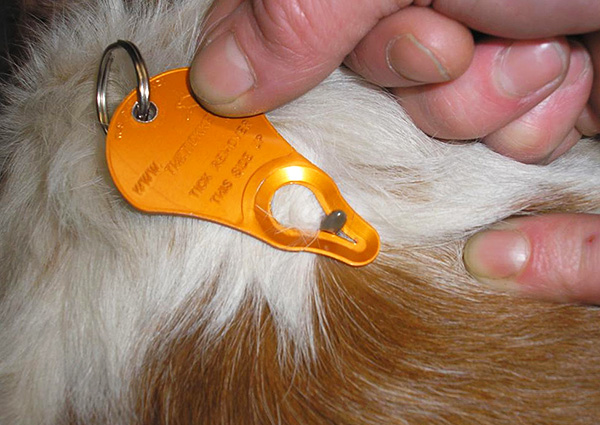
- Tick removal spoons are plastic products that look like small spoons with a cutout in the scoop. They are convenient because the parasite that has been pulled out remains on the scoop, and it is convenient to immediately transfer it to the test tube so that it can be delivered for analysis. The disadvantages of spoons are the same as those of flat extractors;
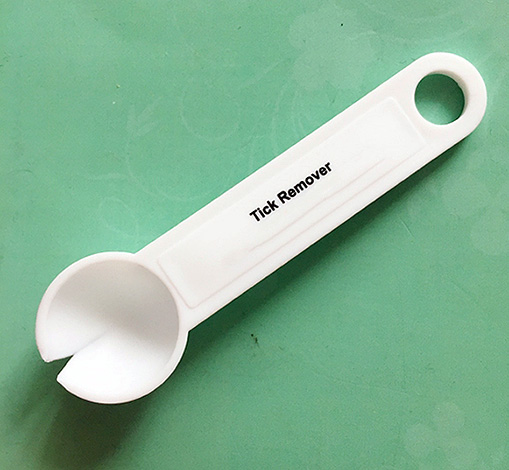
- Lasso handles in which the tick is fixed in a loop of fishing line or thin wire. Allowing ticks to be pulled out even from hard-to-reach places, but it is sometimes difficult to throw a loop on the parasite itself (especially if it is done in an animal — for example, a puppy or kitten will hardly sit still). In addition, the disadvantage is that the construction itself, due to the presence of several moving parts, is not reliable enough and can break down during the trip;
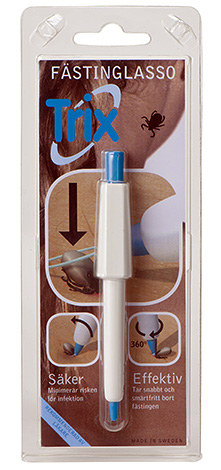
- Special tweezers, in which the tweezers are opened when the cap is pressed and compressed when released. In their advantages and disadvantages, they are quite similar to the lasso pens.

We should also mention the removal of ticks from hard-to-reach places - for example, when the parasite sticks in the auricle, in the groin or between the fingers. Not all tinkers here are able to help ...
Removal of a parasite that stuck in difficult places: in the ears, between the fingers, in the groin
The principle of removing ticks in difficult places remains the same as in other cases - the parasite must be twisted (no matter which way) until it falls out of the skin. But given the specificity of individual areas on the body, in some cases, this process has nuances.
One of the most difficult tasks is removing ticks between the toes on the paws of domestic animals. Firstly, it is quite difficult to get here to the parasite, and secondly, it is almost impossible to unscrew the tick here with most devices.
If the tick stuck between the fingers of a person or a large dog, then it can be hooked and unscrewed with a lasso handle, since the fingers can be placed wide enough to fit this tool between them. If there is no special lasso pen for removing ticks, the parasite can be unscrewed using a regular thread (this will be written a little later).
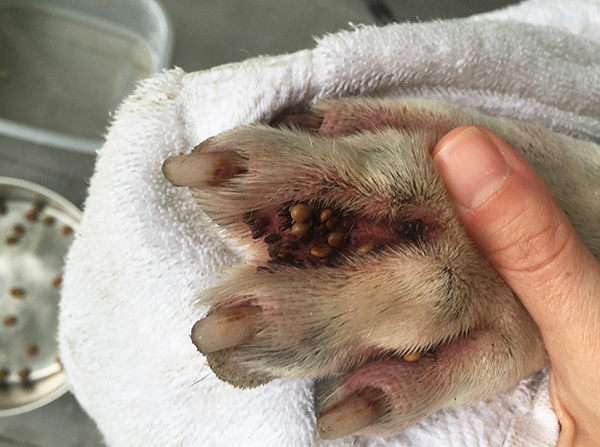
Fortunately, between the fingers, ticks suck quite rarely.
A more common option is ticks in the ears of a dog. In dogs with cropped ears, parasites cling directly to the edge of the ear. From here it is easy to remove them with any device, but from the very ear of the bloodsucker you can only unscrew it with a tweezers or a lasso pen. At the same time, great care must be taken so that in case of an accidental sudden movement of the animal, the pen does not damage the pet's ear.
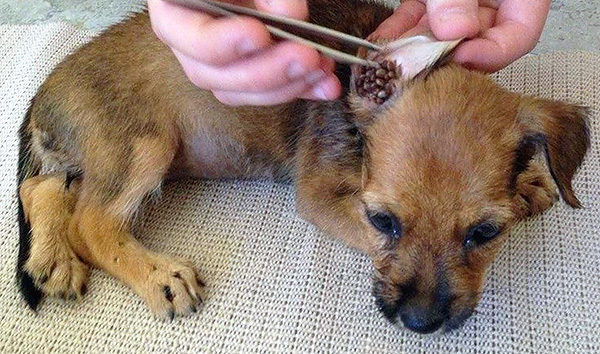
Finally, it is not uncommon for a tick to stick between a person’s buttocks, on the back, on the back of the neck, on the back of the head. That is, where it will be problematic for the victim himself to unscrew the parasite.
The easiest way to remove a tick in this case is to ask the other person to do it. In the conditions of a hike, fishing or hunting is the norm, if there is a partner nearby. If a person is one, then often the only way out for him is to simply try to pull the parasite out, but do it as carefully as possible, trying at least to twist it with your fingers, pull it in different directions, and pull it out slowly without pulling.
In many cases, removing ticks from dogs and cats is also difficult - if only because the animal either wants to run and does not sit quietly (and therefore, one owner’s hand is busy holding the pet), or the animal has been taught the bitter experience of constant painful ticks and simply does not allow this to be done by clearing the head and running away. If at home you can not safely carry out the procedure, it is better to contact your veterinarian.
The photo below shows just a non-standard case of tick sucking (in a dog’s mouth):
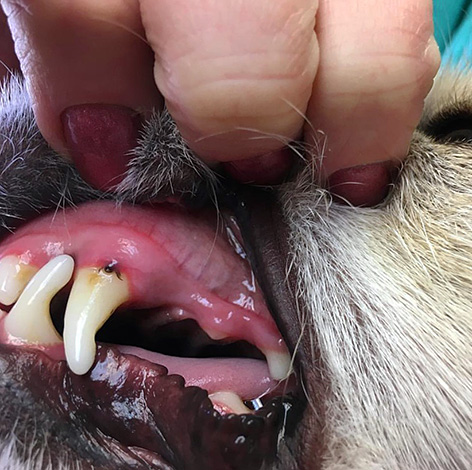
If there is no tick at hand ...
Even despite the great popularity of tick extraction devices, in practice often these devices are not at hand either among the injured or among people nearby.
In such situations, the simplest "twist" can be made with your own hands from the available materials:
- From the thread - this is the easiest and most affordable option. For this, it is enough to cut off any thin thread more than 10 cm long. In the middle, it folds into a loop, attacks a tick, a simple single knot is made on it, which is tightened around the parasite's head.Then both ends of the thread are clamped together between the fingers and with their rubbing movements of the fingers they rotate, alternately intercepting one or the other hand. When the ends of the threads tightly twist around each other, they will begin to twist the tick, and it will fall out;

- A slice is made from the stick with a knife or scissors to make a flat end, a tapering slit is made in it, and then the mite is removed with the obtained tool as a flat extractor;
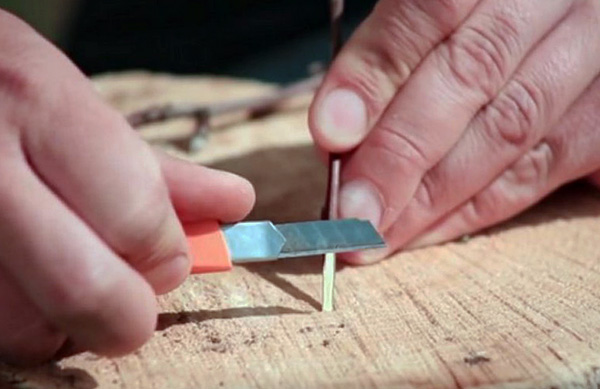
- Tweezers from a manicure set or first-aid kit. Here it is important to pick up the tick as close as possible to the skin, so as not to clamp its body, but the head, and more importantly - to rotate the tweezers so as not to weaken the grip. Otherwise, when unclenching tweezers, the tick will “unwind” in the opposite direction (besides, it can be accidentally crushed during the next capture).
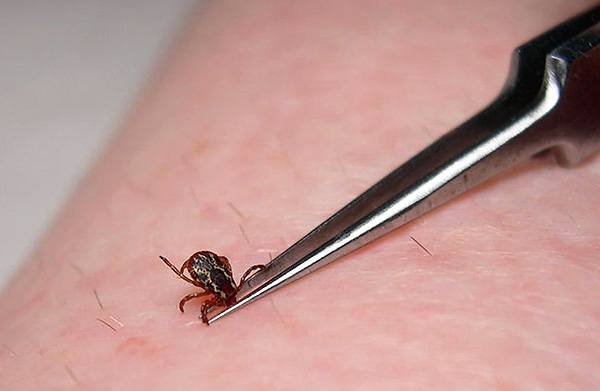
Finally, if there are no devices at all, then you can try to unscrew the tick by picking up nails under the body (this is not always easy to do). In most cases, the bloodsucker is removed from the skin entirely.
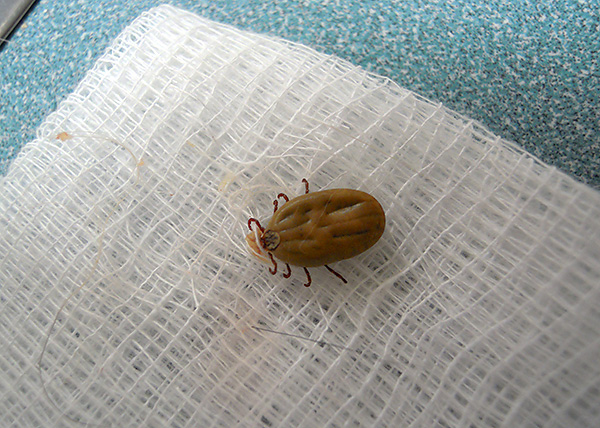
There is no need to be especially afraid that with pressure on the tick, the blood sucked earlier (and even more so, tick-borne encephalitis or borreliosis infected with the causative agents of the insides) will be squeezed out of the parasite back into the wound.The probability of this is extremely low: the mite body covers are strong enough, and the esophagus works as a reliable check valve. With a strong squeeze, the parasite's body will in the worst case burst with splashing contents, but the blood itself will not squeeze into the wound.
On a note
The longer the tick sucks blood, the stronger it is fixed in the skin. As noted above, the cement sheath hardens gradually, within half an hour or an hour, and some time is needed to release enough saliva for it. That is, if the parasite was found in the skin during the first hour after suction, then it will most likely be able to be pulled out quite easily and safely.
In addition, it should be borne in mind that the longer a parasite sucks blood, the more infectious agents it can inject into the wound along with its saliva.
Trying to remove the tick, lubricating it with vegetable oil or burning it with a match, is useless. For each individual to cling to the victim - this is a chance that falls just a few times in life. If the parasite doesn’t feed itself to the end, comes off the victim and falls, then it will die with high probability, leaving no posterity, because there are not so many chances to wait for the new victim.Therefore, it is so biologically incorporated that the mite can tolerate any “mockery”, but it will not unhook itself from the skin. Neither oil nor other methods of depriving him of oxygen will not force him to release the owner to full saturation.
The probability of infection with tick-borne encephalitis and borreliosis
If a tick stuck in an area that is epidemiologically unfavorable for tick-borne infections, it can infect a person with deadly infections — tick-borne encephalitis, Lyme borreliosis or some of the more rare ones. Pets can become infected with pyroplasmosis, which is life-threatening, as well as less dangerous spotted fever, ehrlichiosis and other infections.

The probability of infection can vary greatly, depending on the region in which the tick attacked a person. So, if a region is considered dangerous for tick-borne encephalitis, then the probability of contracting the disease is no more than 0.24%. That is, out of 10,000 bites in the most dangerous regions, only 24 result in the development of the disease. In regions with a low risk of infection, this figure is even lower.
The infection itself is transmitted through the saliva of the bloodsucker - it is in the salivary glands that the pathogens accumulate, which enter the wound when the secretion is excreted by the tick.This happens already in the first minutes after the parasite was inserted into the skin, and therefore if a tick stuck, then a person or an animal could already receive a portion of pathogens. It happened, or not, is difficult to establish immediately, but measures to prevent the development of the disease in some cases need to be taken immediately.
In general, the probability of infection from a sucking tick depends on several factors:
- From the concentration of infected ticks in a particular region. The most dangerous such regions in Russia are, for example, the Tomsk Region, the Krasnoyarsk Territory, Altai and the Far East;
- From the number of ticks adhering to a person (some hunters take dozens of parasites after a day of running);
- From the presence of immunity in the bitten (including immunity, formed tick-borne encephalitis vaccination).
On a note
Until the tick stuck, he cannot infect a person. With simple contact with the skin and moving through it, it does not transmit pathogens.
Thus, any tick that is on the skin or clothing, it is highly desirable to detect and remove before suction.To do this, when walking in places of possible meeting with the parasite, you should check your pants, clothes and legs every 20-30 minutes - most ticks will be removed in this case before they can dig into the skin and begin to suck blood.
Tick removed. What's next?
Immediately after removal of the tick, it is highly desirable to treat the remaining wound with a solution of any antiseptic - iodine, brilliant green, hydrogen peroxide. This slightly reduces the likelihood of tick-borne infection, but above all reduces the risk of wound suppuration due to third-party pathogens.
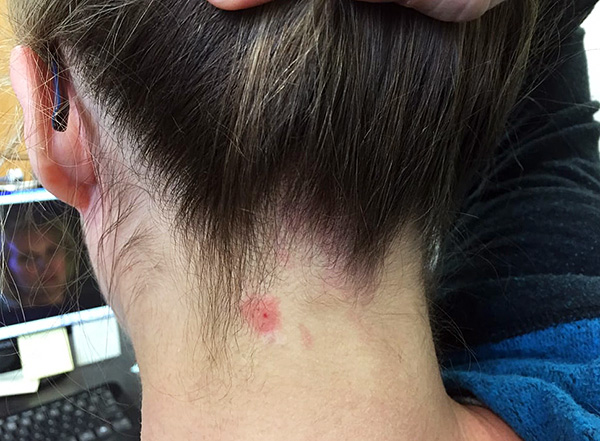
In a region dangerous for tick-borne encephalitis, a person without vaccination should take a dug tick for analysis to a special laboratory. Addresses and phone numbers of such laboratories are known in hospitals and emergency centers.
After unscrewing the tick, it should be placed in a hermetically sealed container (for example, in a jar, in extreme cases - in a bag, which can be tied up) and taken to the laboratory as soon as possible. Even if it was suddenly discovered that the twisted parasite had died (or was crushed when it was pulled out), it would still be worth taking it for analysis - it is possible to detect pathogens within 2-3 days after the death of the parasite.
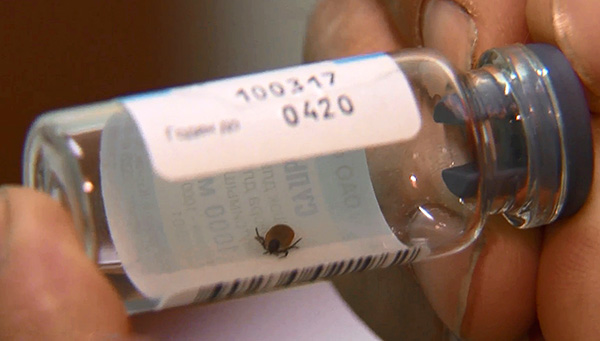
If the bite occurred in a dangerous area for CE, a person without vaccination in the first few hours after the incident, it is desirable to carry out emergency prevention of tick-borne encephalitis. - injections with the introduction into the body of serum containing antibodies to the pathogen virus (for more information about the use tick immunoglobulin with tick bites). Even if an infection has occurred, such prophylaxis is likely to protect against the development of the disease and its dire consequences. Conduct emergency prophylaxis of TBE in most public hospitals, it is only important to go there during the first 3 days after the bite.
If neither the tick is taken for analysis, nor emergency prophylaxis fails, you need to carefully monitor the condition of the victim. If within 2-3 weeks his temperature starts to rise, a fever develops, pains in the head appear, or characteristic pink spots in the form of rings appear around the bite, then the person should be taken to hospital as soon as possible. The sooner they start treating him, the more chances he will have to survive and not become disabled.
If you have personal experience in extracting sucked ticks, be sure to share the information by leaving your review at the bottom of this page.
Interesting video: how you can easily and safely remove the tick
Many examples of mite extraction with a mite

